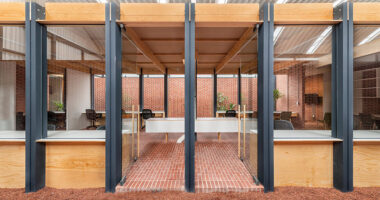Nestled in the picturesque landscape of Yibin, Sichuan Province, Gaoqiao Village stands as a testament to rural beauty and cultural heritage. With a focus on bamboo culture and industry, the village has emerged as a beacon of rural revitalization, attracting visitors from far and wide. However, amidst the surge of tourism, the importance of essential facilities like public toilets often goes unnoticed. Recognizing this gap, FMD Architects embarked on a project to integrate functionality with agricultural tourism, resulting in the innovative Gaoqiao Village Pedestrian Bridge.

Embracing Local Context
Situated at the entrance of the village amidst sprawling farmland, the project site presented a unique opportunity to merge the daily lives of farmers with the needs of tourists. The design concept revolves around the themes of “connection” and “support,” seamlessly blending the functions of a pedestrian bridge with those of a public toilet. By leveraging sustainable ecological technologies, the bridge not only enhances the village’s infrastructure but also contributes to its aesthetic appeal.
Innovative Design Solutions
The architectural design of the bridge-toilet hybrid is characterized by its three-dimensional folding of structural walls, creating a self-supporting system that integrates seamlessly with the surrounding landscape. The upper level of the bridge houses male and female toilets, cleverly designed within the constraints of limited width. Below, the lower level accommodates a family bathroom, an accessible bathroom, and a storage room for agricultural tools, catering to the diverse needs of villagers and tourists alike.

Blending Tradition with Modernity
The construction materials reflect a harmonious blend of tradition and innovation. The outer facade, crafted from rough bamboo formwork concrete walls, pays homage to local craftsmanship and materials. In contrast, the inner walls feature smooth green tiles, adding a touch of modernity to the structure. This juxtaposition of textures creates a visually striking exterior while promoting local craftsmanship and materials.
Community Engagement and Rural Revitalization
Throughout the construction process, FMD Architects prioritized community engagement and collaboration with local workers and bamboo craftsmen. By actively involving the local community, the project not only revitalized the village but also promoted economic growth and sustainability in the region. Through the seamless integration of architecture and agriculture, the Gaoqiao Village Pedestrian Bridge stands as a testament to the transformative power of design in rural development.

Conclusion
In conclusion, the Gaoqiao Village Pedestrian Bridge represents a harmonious fusion of functionality, innovation, and community engagement. By addressing the overlooked need for public facilities while celebrating local culture and craftsmanship, this project serves as a model for sustainable rural development in China and beyond.






















